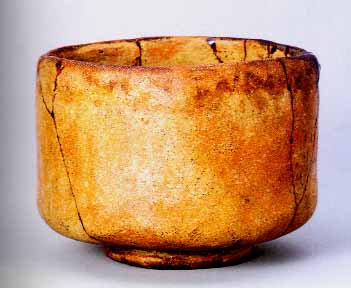| architecture |
| calligraphy |
| ceramics |
| clothing |
| comics |
| gardens |
| lacquerwork |
| literature |
| movies |
| music |
| painting |
| poetry |
| sculpture |
| tea ceremony |
| television |
| theatre |
| weaponry |
| thematic routes |
| timeline |
| the site |
context: ceramics > tea ceremony > raku
Why So Admired?

|
a Chojiro tea bowl called Tsutsumi-gaki |
It can be hard to see why these tea bowls have such a central place in Japanese aesthetics. They are simple, they appear to be rather clumsily made (always by hand, not on the wheel), there is no decoration, and the glazes are often dull. Some of the answers can be found in the pages on Rikyu in the tea ceremony section here - the Zen concepts of wabi, of naturalness and simplicity, are important here. Part of it is as simple as 'Rikyu said so': an almost godlike person chose them, so they're great. We shouldn't underestimate factors like that.
But why did he choose this style? Well, green tea looks good in these dark and simple bowls. The clay, firing and thickness makes for insulation such that they feel good when filled with hot tea. They feel good - natural - in the hands in a way that porcelains and so on don't. (Obviously I say this from other accounts - these are museum pieces, so the likes of me never gets to touch any, let alone fill them with tea.)
The aesthetics here are very different from those of the West, but I can see real beauty in these items.
